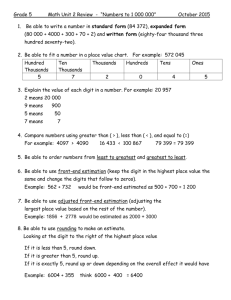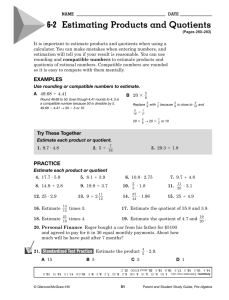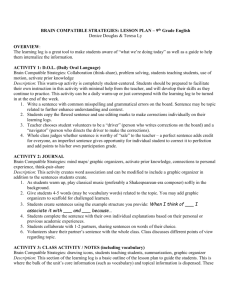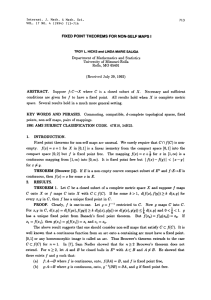VARIANT OBSERVATIONS A COMPATIBILITY
advertisement
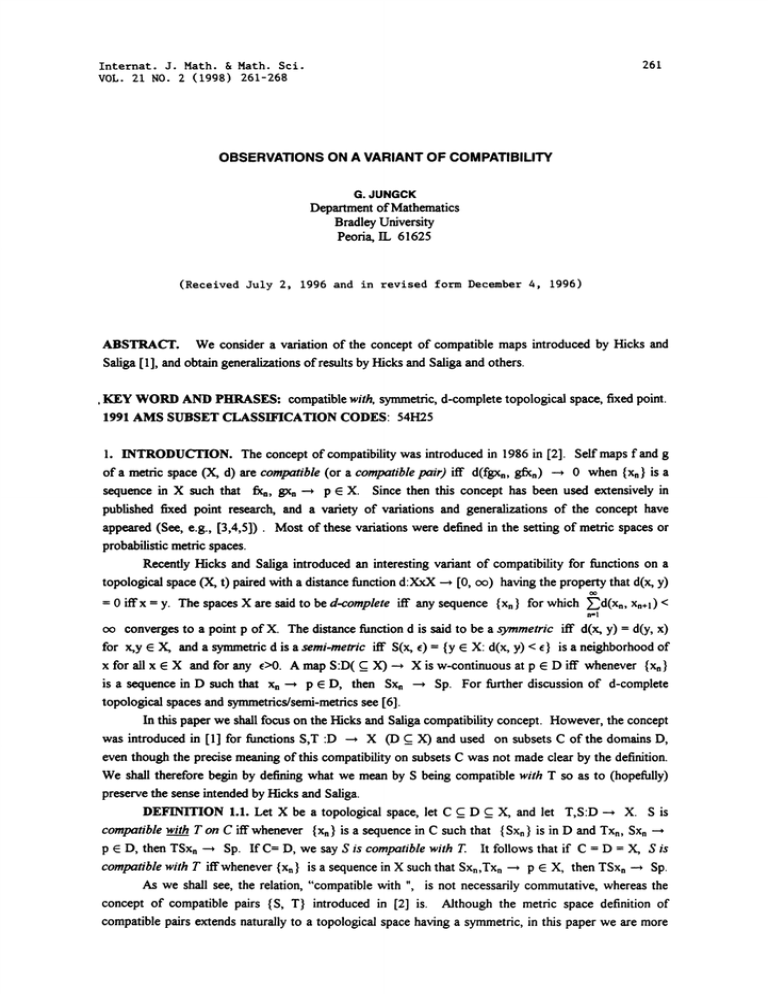
261
Internat. J. Math. & Math. Sei.
VOL. 21 NO. 2 (1998) 261-268
OBSERVATIONS ON A VARIANT OF COMPATIBILITY
G. JUNGCK
Department of Mathematics
Bradley University
Pcoda, IL 61625
(Received July 2, 1996 and in revised form December 4, 1996)
ABSTRACT. We consider a variation of the concept of compatible maps introduced by Hicks and
Saliga 1], and obtain generalizations ofresults by Hicks and Saliga and others.
KEY WORD AND PHRASES: compatible with, symmetric, d-complete topological space, fixed point.
1991 AMS SUBSET CLASSIFICATION CODES: 54I-I25
1. INTRODUCTION. The concept of compatibility was introduced in 1986 in [2]. Self maps f and g
0 when {Xn is a
of a metric space (X, d) are compatible (or a compatible pair) iff d(fgXn, gfx,)
sequence in X such that fxn, gxn "-* p e X. Since then this concept has been used extensively in
published fixed point research, and a variety of variations and generalizations of the concept have
appeared (See, e.g., [3,4,5]). Most of these variations were defined in the setting of metric spaces or
probabilistic metric spaces.
Recently Hicks and Saliga introduced an interesting variant of compatibility for functions on a
topological space (X, t) paired with a distance function d:XxX [0, oo) having the property that d(x, y)
0 iff x y. The spaces X are said to be d-complete iff any sequence {Xn for which d(x,, Xn+l) <
oo converges to a point p of X. The distance function d is said to be a symmetric iff d(x, y) d(y, x)
for x,y X, and a symmetric d is a semi-metric iff S(x, ) {y E X: d(x, y) <
is a neighborhood of
-,
c_
x for all x E X and for any >0. A map S:D( X)
X is w-continuous at p E D iff whenever {xn
is a sequence in D such that Xn
Sp. For further discussion of d-complete
p 6 D, then Sxn
topological spaces and symmetdcs/semi-metdcs see [6].
In this paper we shall focus on the Hicks and Saliga compatibility concept. However, the concept
was introduced in [1] for functions S,T :D
X (D C_ X) and used on subsets C of the domains D,
even though the precise meaning of this compatibility on subsets C was not made clear by the definition.
We shall therefore begin by defining what we mean by S being compatible with T so as to (hopefully)
preserve the sense intended by Hicks and Saliga.
DEFINITION 1.1. Let X be a topological space, let C c_ D _C X, and let T,S:D
X. S is
compatible with T on C iff whenever {Xn is a sequence in C such that Sxn is in D and Tx, SXn
p D, then TSxn
Sp. If C D, we say S is compatible with T. It follows that if C D X, S is
compatible with T iffwhenever {xn} is a sequence in X such that Sn,Tn
Sp.
p X, then TSxn
As we shall see, the relation, "compatible with ", is not necessarily commutative, whereas the
concept of compatible pairs {S, T} introduced in [2] is. Although the metric space definition of
compatible pairs extends naturally to a topological space having a symmetric, in this paper we are more
G. 3UICK
262
interested in a property shared by these two compatibility concepts, namely, weak compatibility. Weak
compatibility was defined in [7] for semi-metric spaces. We now define it for any set X.
X. S and T are weakly
DEFINITION 1.2. Let X be any set, let C C_ D C_ X, and let T,S" D
compatible on C iff x E C and Tx Sx E D)
(STx TSx). If C D, we say that S and T are
or the pair S,T} is weakly compatible.
weakly compatible
In the following N will denote the set of positive integers, and for k N, Nk is the set of all
n N such that n < k. If S is a map, we shall write Sx for S(x) when convenient and the meaning is
clear. Moreover, we require that the topological spaces (X, t) be Hausdorff (which we designate "T2")
to ensure that converging sequences have unique limits (See example 2.2 in [7]).
=
2. TltEOREMS AND RESULTS.
PROPOSITION 2.1. Let (X, t) be a T2 topological space and let C C_ D C_ X. Let S,T:D
X and suppose that S is compatible with T on C.
1. If x C and Sx Tx D, then T2x TSx STx S2x.
2. If {x } is a sequence in C such that Sxn E D for n N and Sxn, Txn
p D, and if T is wcontinuous at p, then Sp Tp.
3. If C=D=X and both S and T are w-continuous, then T is compatible with S.
Tx (//D,
PROOF. Suppose that x C and Sx Tx D. Let xn x for n E N. Then Sxn,Txn
and TSx
STx since S is compatible with T on C; i.e., the conclusion 1. holds. To see
--n InooTSxn
that 2. is true, note that TSxn "-+ Sp since S is compatible with T on C. But since T is w-continuous at
p and {Sxn} is a sequence in D convergent to p, TSxn -+ Tp. But (X, t) is T2 and therefore limits of
sequences are unique; i.e., Tp Sp.
And to prove 3., suppose Txn, Sxn "- p X. Since S is w-continuous, STxn
Sp. But Sp
[2
with
S.
2.
Tp by and therefore STxn Tp; i.e., T is compatible
Note that Proposition 2.1.1 tells us that ifS is compatible with T (on C), then the pair {S, T} is
weakly compatible (on C), even though- as the next example shows- T is not compatible with S. The
following example also shows us that the conclusion of Proposition 2.1.2 need not hold if S is
compatible with T and T is no_.!t continuous at p, even though S is continuous at p.
EXAMPLE 2.1. Let X [0, 1] with d(x, y) [x Y I, let S (the identity map) and define
T:X X by Tx--(2x+3) $’ if x[0, -) and Tx 0 if x
1]. ,Now, as will be shown
from the left, Tx
momentarily, is compatible with (any) T and certainly is continuous. But if x
whereas T(1/2) 0; i.e., T is not compatible with I. And T() 0 # 1/2 I(!)2,so
ITx
the conclusion 2 in Proposition 2.1 does not hold.
In that which follows, we shall use the collapsing principle for series. Thus, if ak is a sequence
,
, ,
of numbers, then
(a a/) a a
for n E N.
TREOREM 2.1. Let (X, t) be a d-complete T2 topological space and let D be a closed subset of
X. Let S,T:D
X where S(D) C_ D N T(D). Suppose there is a map c:D
[0, oo) such that
d(Tx, Sx) < c(Tx) c(Sx) for x Tq(D).
Then, if xo D _q sequences {x },{y in D such that y Sxa.t Tx for n N and y
p D.
Moreover, ifT is w-continuous at p and S is compatible with T on T (D), then Sp=Tp.
PROOF. Since S(D) _C T(X), given xo E D, we can choose x D such that Tx Sxo. We
can then choose x2
D such that Tx2 Sx. In general, given x, D for Nk such that Tx,= Sxi.,
we can choose xk+ E D such that Txk+ Sx. Thus, by induction, a sequence {Yn} of the type cited in
the statement of the theorem exists. Since Tx Sxk. D for k N, x T (D) for k N, so for
k E N we can write:
"
OBSERVATIONS ON A VARIANT OF COMPATIBILITY
d(yk, Yk+l)
d(Txk, Sxk) _< a(Tx)-a(Sxk)
a(yk)- c(yk+)
263
which by the collapsing
principle implies
d(yk, Yk+l)
a(yl)
c(y.+l) _< a(yl), for n e N.
k=l
Thus
d(Yk, Yk+l) < oo. Therefore,
k=l
-
Yk
P E X since (X, t) is d-complete.
Consequently, Sxk, Txk
p. But SXk E D for k E N and D is closed, so that p E D. Moreover, if S
is compatible with T on T"l (D) and T is w-continuous at p, since Xk 6 T"I (D) for k 6 N, Proposition 2. I.
(with C Tl (D)) implies that Tp Sp. El
Example 2.1 shows us that even though the identity map on a space X is compatible with any
map on X, 3 maps S on X not compatible with I. The following proposition says that nice things happen
when a function S is compatible with I.
PROPOSITION 2.2. Let X be a T2 topological space and let D C_ X. Suppose S:D X and
is the identity map. Then is compatible with S. Moreover, if S is compatible with and Sx. and
{x. are sequences in D which converge to p 6 D, then Sp p. And if S is w-continuous, then S is
compatible with I.
PROOF. To see that is compatible with S, let {x. be a sequence in D such that Ix. x,
Sx. p 6 D. Then SIxn Sx. p Ip, so is (trivially) compatible with S.
If S is compatible with and {x. }, Sx. are sequences in D which converge to p E D, then p=
Sp by Proposition 2. (with T I).
Now suppose that S is w-continuous and let {x. }, SXn be sequences in D such that Ix., Sx.
Sp by continuity. Thus, Sxn ISxn Sp, and hence S
p 6 D. Then, since Ix,( xn)
p 6 D, Sx,
is compatible with I. El
The last sentence in Proposition 2.2 prompts the question, "If S:D X is compatible with (the
identity map), is S continuous on D?" The next example tells us that the answer is "no", even if S:X
X.
if
X by Sx
EXAMPLE 2.2. Let X [0, 1] with the usual metric and define S: X
andSx=0
Now
But
then
p6{0,1}.
0, Sx.
p,
ifIxn(=Xn)
ifSx.
x6[0,]
ifx6(,l].
and if Ix.-- 1, Sx.-* 0; i.e., there is nop6X such that Ixn, Sx. --p. Thus, S is
compatible with vacuously, but S is certainly not w-continuous.
COROLLARY 2.1. Let (X, t) be a d-complete T topological space and let S:X X. If there
exists a map a: X
[0, oo) such that for x X
d(x, Sx) < a(x)- a(Sx),
then for any x X, Sn(x)
p for some p Px X. If S is compatible with the identity map, then Sp
-----p.
(To see that P=Px need not be unique, let S I, the identity map.)
PROOF. If we let T I, the identity map, in Theorem 2.1, then Yn xn SXn-l for n E N.
Thus, Yn-- Snxo for n E N. Since I(X) X, the conclusion follows. El
NOTE 2.1. Corollary 2.1 is the topological version of Caristi’s Theorem [8] for complete metric
spaces. Caristi required that c be lower semi-continuous, whereas we required that S be compatible with
the identity map. Dien [I0] noted -as Browder [9] had already known in 1975 -that for metric
spaces, the lower semi-continuity requirement on c can be dropped by requiring that S be continuous. In
view of Example 2.2, Dien’s comment suggests that Corollary 2. is of interest.
COROLLARY 2.2. Let (X, t) be a d-complete T2 topological space and let T:D
X, where D
is a closed subset ofX. IfD C_ T(D) and if3 a map c: X
[0, oo) such that
-
-
G. JUNGCK
264
d(Tx, x) _< c(Tx)- c(x), for x /T"l (D),
then any xo E D determines a sequence ix.} with x,.= Txn such that xn
p E D. IfT is w-continuous
at p, then Tp p.
PROOF. Let S I, the idemity map in Theorem 2.1., and note that is compatible with T by
Proposition 2.2. C!
TREOREM 2.2. Let (X, t) be a d- complete Hausdorff topological space and let D be a closed
subset of X. Suppose S, T: D
X and that S(D) _C D f T(D). If 3 maps a, :X
[0,oo) and
r (0, 1) such that
(*) d(Sx, Sy) _< r d(Tx, Ty) + (a(Tx) a(Sx) + ((Ty) -/(Sy))
for x,y T’I(D), then for any xo D, S sequences ix=}, {y,} such that y= Tx, Sx.l for n N
and y,
p p E D. If S is compatible with T on T (D) and T is w-continuous at p, then Tp Sp
p, and p is the only common fixed point of S and T.
PROOF. Let xo D. As in the proof of Theorem 2.1, we construct the sequences ix,}, {y,}
in D such that y= Txn Sx. D for n N. Then xk T (D) for k E N, so (*) implies for k E N:
-
"
"
d(yk, Yk+)= d(Sxkd, Sxk)
<_ r d(Txkd, Txk) + (c(Txkq) c(Sxkq)) + (/3(Txk) -//(Sxk)), or
d(yk, Yk+) < r d(yk-l, Yk) + (a(yk-l) CO’k)) + (/(Yk) --/(Yk+)).
Then the collapsing principle yields:
n+l
d(yk, Yk+l)
k=l
--<
n+l
r ’jd(yk-,, Yk) + (c(yo)
of(Yn+l)) + ((Yl)
/(Y,+2) ), or
k=l
d(yk, Yk*l) + d(yn+l,
k=l
< r
n
d0’z, Yk+,) + r d(yo, Yl) + (Yo) + (Yl).
k=-I
We drop the second tcfm {n the {eR member of the last inequality above to obtain,
(I r) d(Yk, Yk+l) < a(yo) +//(y, + r d(yo, y, M, a constant _> 0.
k=l
Thus, for n E N: ’d(yk, Yk+l) _< M(I
r)"l a nonnegative re,a{, since 0 < r < I. Therefore,
k=l
d(yk, Yk+l) < oo, and {Yk converges to p 6 X since X is d-complete. So Txk, Sxk -+ p Pxo. But
Sxk 6 D for k 6 N and D is closed, which implies that p 6 D. By the above, {Xk is a sequence in C
T"l (D) such that Sxk 6 D for k 6 N, and Txk,Sxk
p 6 D. Therefore, if S is compatible with T on
Tq (D) and T is w-continuous at such a p, Proposition 2. (2). implies that Sp Tp. But since p D,
Sp(=Tp) E D, so that p 6 T"l (D). Thus Pfoposition 2. l(1) with C T"l (D) tel{s us that
S2p STp TSp T2p
(2.1)
Moreover, since Tp Sp E D and TSp SSp D, we know p, Sp T"I (D). So (*) implies
d(Sp, SSp) _< r d(Tp, TSp) + (a(Tp) a(Sp)) + ((TSp) (STp)) d(Tp, TSp) + 0;
i.e., d(Sp, SSp) < r d(Sp, SSp) by (2.1). Since 6 (0, I), and d(x, y) 0 implies x=y, we have Sp
SSP. Then Sp SSp TSp by (2. I), so that Sp is a common fixed point S and T. That Sp is the only
common fixed point of S and T follows easily from (*). {"{
If we let
,
be identically 0 in Theorem 2.2, we obtain the sufficency portion of Theorem 3. in
[I], with the assumption that the phrase, "g is compatible with f on f(C)" in the statement of the
Theorem 3. conforms to our definition. Note also that the argument given in the proof of Theorem 3. to
prove the necessity portion could be used to obtain a necessary and sufficient condition that the T in
Theorem 9_.2 have a fixed point.
OBSERVATIONS ON A VARIANT OF COMPATIBILITY
265
NOTE 2.2 In this paper, Q denotes a nondccreasing map Q:[0,oo)
[0, oo) such that Q(t) <
for > 0 and Q"(t) converges for all t. Consequently, Q(O) o, and d(x, y) _< Q(d(x, y)) implies
tt=l
that x y.
Our final result appeals to the following lemma.
LEMMA 2.1. Let (X, t) be a d-complete topological space with d symmetric, and let D C_ X.
Let A,B,S,T: D --. X, such that A(D) C_ T(D) and B(D) C S(D). If
(i) d(Ax, By) < Q(m(x, y)) for x,y 6 X, where
m(x, y)= max d(Ax, Sx), d(By, Ty), d(Sx, Ty) },
then the sequences {y. defined below in (ii) exist for any x 6 D and converge to a point p 6 X.
(ii) y2. Sx2. Bx2.-l, y2..l Ax2._ Tx2.., and x. 6 D for n 6 N tJ {0}.
Lcmma 2. is proved in [7]. It is proved for a semi-metric d, but is valid if d is a symmetric. In
[7] the sequence {y, is proven to be "d-Cauchy" which justifies the conclusion above that, with the
above hypothesis of"d-completeness", {y. converges to a point p X.
THEOREM 2.3. Let (X, t) be a d-complete Hausdorff topological space with d symmetric and
let D be a closed subset of X. Suppose A,B,S,T:D --, X, A(D) C_ D N T(X) and B(D) C_ D N SO:)). IfS
and T are w-continuous, if (i) in Lemma 2.1 holds, and if A(B) is compatible with S(T), then A,B,S,
and T have a unique common fixed poim.
PROOF. Let Xo 6 D and let {y. }, {x. be sequences assured by Lemma 2. I, so that we have
p 6 X.
Yn, AX2n, BX2n-], SX2n, Tx..
We know that p 6 D since Ax2, 6 D for all n and D is closed. Since A is compatible with S and S is wcominuous, and since Ax.,Sx2n---* p 6 D, Proposition 2.1 implies
Ap Sp, and A2p ASp SAp S2p. Similarly,
Bp Tp, and
Bp BTp TBp T2p.
(2.2)
(2.3)
Then by property (i) (Lemrna 2. I),
d(Ap, Bp) _< Q(max{ d(Ap, Sp), d(Bp, Tp), d(Sp, Tp)})
_< Q(max{ 0, 0, d(Sp, Tp)}) Q(d(Ap, Bp)), by (2.2) and (2.3).
Therefore, Ap Bp by Note 2.2, and hence
Ap Bp Sp Tp.
Then (i)implies d(Ap, BAp) _< Q(max{ d(Ap, Sp), d(BAp, TAp), d(Sp, TAp)}), or
(2.4)
d(Ap, BAp) _< Q(max{ 0, 0, d(Sp, TAp) }) Q(d(Ap, BAp)),
by (2.2), (2.3), and (2.4) above. Therefore, Ap BAp. By symmetry we also have Bp ABp.
Therefore, the above equalities yield Ap AAp BAp SAp TAp; i.e., Ap is a common fixed point
of A,B,S, and T. That x Ap is the only common fixed point of A,B,S and T follows from the
contraction property (i). I-I
We now state a result described in the final paragraph in [l l] which is a variation of their
Theorem 5., page 793.
THEOREM 5B. [l Let A, B, S, and T be mappings of a d-topological space (X,t) into itself
satisfying the following conditions:
(a) A(X) C_ T(X) and B(X) C_ T(X),
(b) d(Ax, By _< b( max{ d(Ax, Sx), d(By, Ty), d(Sx, Ty) }) for all x,y 6 X,
where b: [o, oo)
[0, oo), b(0) 0, b is nondecreasing, b is upper continuous,
and b(t) < for > 0,
(c) S and T are w-continuous,
G. JUNGCK
266
(d) A, S and B,T satisfy the Hicks and Saliga definition of compatibility, and
(e) d is a continuous symmetric.
Then A, B, S, and T have a unique common fixed point, provided 3 xo,xl e X such that Axo
On(d(Axo, BxI)) < OO.
Tx
and
Our Theorem 2.3 has Theorem 5B as a corollary. In fact, Theorem 5B has the following
restrictions in the hypothesis not required by Theorem 2.3. The contractive function is upper semicontinuous. A,S and B,T are compatible in the sense of"Hick’s and Saliga’s definition", which suggests
that A(B) is compatible with S(T) and conversely. They also require that the symmetric d be continuous
and that the domains of A,B,S, and T be X.
We should note that Harder and Saliga require that 3 Xo, xl X such that Axo Txl and
On(d(Axo, Bx))
< oo. Thus, their requirement for convergence for one appears to be lighter than
n0
our requirement that
Qn(t) < oo for all
n
the requirements imposed on
[0, oo). However, the next result states that because of
in Co) of the hypothesis, the inequality
on(t) < oo
holds for all if it
n=0
holds for one
(0,oo).
PROPOSITION 2.3. Suppose that :[0, oo)
[0, oo), is upper-semicontinuous,
>
<
<
for 0. If #(to) oo for some to > 0, then
nondecreasing, and that O(t)
_
_ _
_
#(t) < oo for all > 0.
PROOF. We first prove that
(1) n lmoo#(t)-- 0 for anyt [0, oo),
Since is nondecreasing, O(0) O(t) < for any t> 0; therefore (0) 0. So suppose that > 0.
Then ,(t) < t, and O2(t) O(O(t))
0n(t). Thusn lira #(t) c > 0, where #(t)
is upper semi-continuous, :1 6 > 0 such that O(t) < c for
(c 6, c+ 6). Since O"(t) --, c as
n--, oo, om(t) e (c- 6, c+ 6) for some m. Therefore, we have the contradiction om/(t) < c
om+l(t), bythe choice
_
Now suppose that to > 0 and On(to) < oo. Let e (0, oo). By (1)’, we cam choose m N
such that om(t) < to, so
is nondecreasing.
om/(t)
O(to), and in general we have om/n(t)
But then,
om/n(t)
on(to) M < oo,
n=!
rl
Ok(t)
k=l
O(to) for n N, since
and therefore,
’Abk(t) + ’Abm+n(t) <_ bk(t) + M <
k=l
n=!
k=l
3. RETROSPECT. In Definition 1.2 we defined the concept of a weakly compatible pair, and in
Proposition 2.1 we proved in part 1. that "S compatible with T" implies that {S, T} is a weakly
compatible pair. We close with an example which shows that even though S is not compatible with T and
T is not compatible with S, S, T} may be a weakly compatible pair. Moreover, since in this example S
and T have a common fixed point and satisfy a contractive condition, d(Sx, Sy) < d(Tx, Ty), we ask,
to what extent can weak compatibility be used in lieu of the stronger forms of compatibility and still
produce common fixed points.’? (A partial answer can be found in Theorems 3.1 and 3.2 of [7] in the
context of semi-metric spaces.)
267
OBSERVATIONS ON A VARIANT OF COMPATIBILITY
EXAMPLE. LetX= [0, 2],D=[0, I], and d(x,y)=(x-y)2 forx, y6X. LetAx=
(3/4)-(x/2) and Sx=2-3x forx6[0,1/2], and Ax= and Sx=0 for xe(,l]. Then A,S:
D
X and A(X) C_ S(X), and d is a semi-metric but not a metric (no triangle inequality). Now {A,
,
and A() S(1/2)
AS() SA(1/2). On the other
hand consider x. 1/2 ()n for n>l. Then Ax., Sx, ---, 1/2, SAx,
0 but A() 1/2 and AS
3/4 and S()=1/2. Thus A is not compatible with S and S is not compatible with A. But 1/2 is a common
fixed point of A and S, and a quick check shows that d(Ax, Ay) <_ ] d(Sx, Sy).
We conclude by observing that the expression (*) in our Theorem 2.2 was prompted by the
analogous but more general expression (2.1) used by Dien in Theorem 2.1 [9]. The left member of
Dien’s contractive expression (2.1) was d(Sx, Ty) and our expression (*) used d(Sx, Sy). However,
Dien’s theorem is for metric spaces, and a check of his proof(s) reveals the central role of the triangle
inequality, which we did not have for topological spaces with only a symmetric. Note also that the right
member of (2. I) [9] contained an expression of the form
S is weakly compatible since Ax Tx iff x
’
(3. I)
[i(Lx) bi(Sx)]
iffil
where qi" X ---, [0, oo) for /Nn. But if we let c
bi, then
o: X --,
[0, oo) and (3.1) can be
written [c(Ix) c(Sx)] i.e., no generality is gained by using n functions qi in lieu of one function
ACKNOWLEDGMENT. We thank Professor Troy Hicks for forwarding reprints of his work
on d-complete topological spaces. We also thank Professor Michael McAsey whose computer wizardry
made the writing of this manuscript much more manageable.
REFERENCES
[1] HICKS, TROY L and SALIGA, LINDA MARIE, "Fixed point theorems for non-self maps I,"
lnternat. ,I. Math. &Math. Sci. 17 (1994), 713-716.
[2] JUNGCK, G. "Compatible mappings and common fixed points," lnternat. ,I. Math. & Math. Sci. 9
(1986), 771-779.
[3] MISI-IRA, S.N. "Common fixed points of compatible maps in P. M. spaces," Math. Japonica 36
(1991), 283-89.
[4] JUNGCK, G., MURTHY, P. P. and CHO, Y. J. "Compatible mappings of Type (A) and
common fixed points," Math. Jcgonica 38 (1993), 381-390.
[5] JUNGCK, G. and RHOADES, B.E. "Some fixed point theorems for compatible maps,", lntermat.
J. Math. &Math. Sci., 16 (1993) 417-428.
[6] HICKS, TROY L. and ILHOADES, B. E. "Fixed point theorems for d-complete topological spaces
II," Math. Japonica 37 (1992), 847-853.
[7] JUNCK, G. "Common fixed points for noncontinuous nonself maps on nonmetric spaces," Far
East,l. Math. Sci. 4 (2)(1996) 199-215.
[8] CARISTI, J. "Fixed point theorems mappings satisfying inwardness conditions," Trans. Am. Math.
Soc. 215 (1976), 241-51.
268
G. JUNGCK
[9] BROWDER, FELIX "Fixed Point Theory and Its Applications" (S. Swaminatham, ed. ),
Academic Press, 1976.
10] DIEN, NGUYEN HUU "Some remarks on common fixed point theorems,"
87 (1994), 76-79.
,/. Math, anal.
Appl.
[11] HARDER, ALBERTA and SALIGA, LINDA MARIE "Periodic and fixed point theorems in dcomplete topological spaces," Indian J. pure appl. Math. 26 (1995), 790-796.

